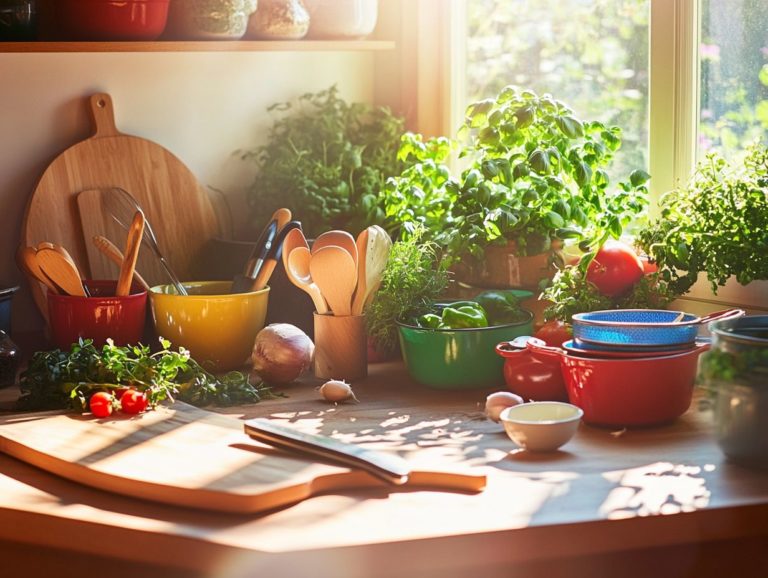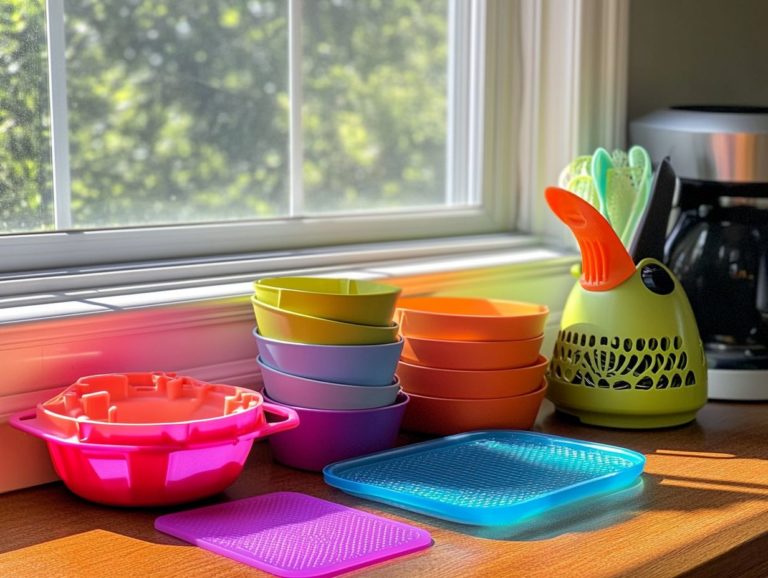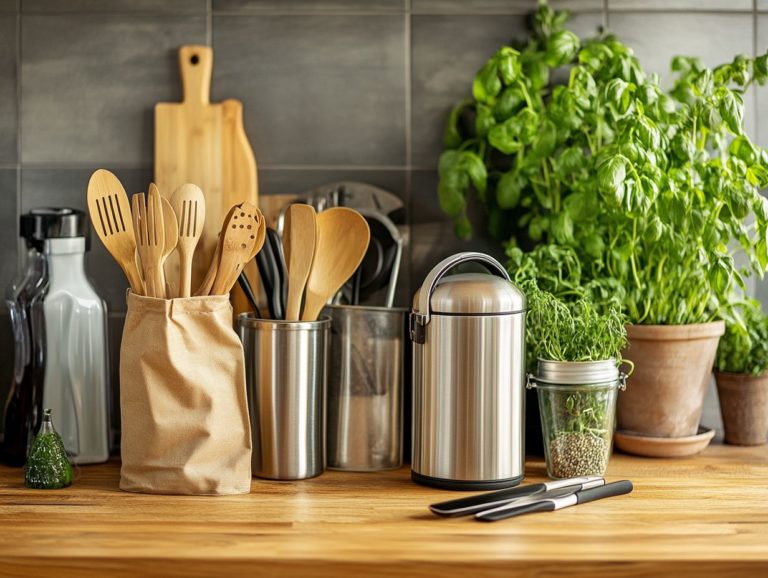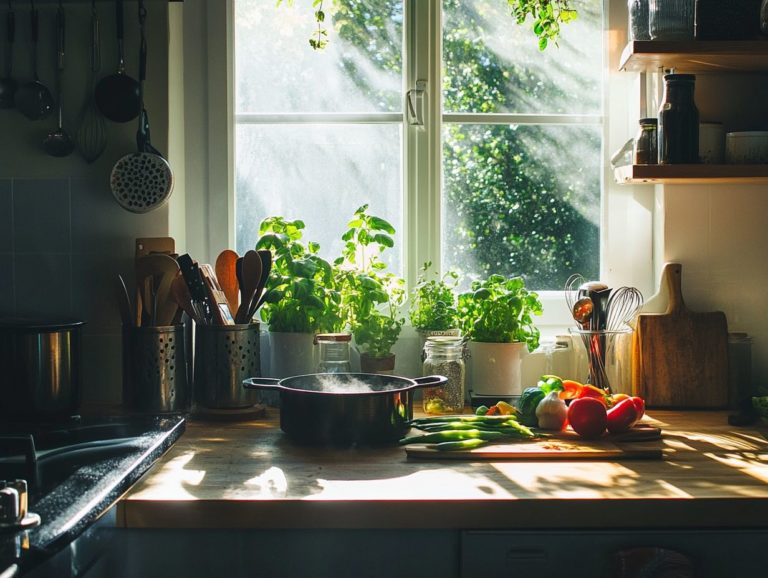How to Care for Your Kitchen Accessories
In every kitchen, the right accessories are indispensable, elevating both functionality and your overall cooking experience. Ensuring cleanliness and making informed purchasing decisions are paramount. Taking proper care of these tools is essential.
This guide offers effective cleaning techniques, smart storage solutions, and tips on when to upgrade your items. You ll uncover creative uses for your kitchen accessories that ignite your culinary creativity.
Embrace the journey to maximize their potential!
Contents
- Key Takeaways:
- Proper Cleaning and Maintenance
- Choosing the Right Kitchen Accessories
- Replacing and Upgrading Your Accessories
- Creative Uses for Kitchen Accessories
- Frequently Asked Questions
- How should I clean my kitchen accessories?
- What is the best way to store my kitchen accessories?
- How often should I replace my kitchen accessories?
- Can I put my kitchen accessories in the dishwasher?
- How can I prevent rust on my metal kitchen accessories?
- What should I do if my wooden kitchen accessories show signs of wear?
Key Takeaways:

- Regular cleaning and maintenance are essential for prolonging the life and quality of your kitchen accessories. This includes using specific cleaning techniques for different types of accessories, along with proper storage and organization.
- When choosing kitchen accessories, consider factors such as durability, functionality, and style to ensure they meet your needs and complement your kitchen.
- Don’t hesitate to replace old or worn-out accessories. Look for ways to upgrade and repurpose them for creative uses in your kitchen.
What are Kitchen Accessories?
Kitchen accessories are critical tools that elevate your food preparation and cooking efficiency. From versatile kitchen gadgets to specialized utensils like cutting boards, dish rags, and storage containers, each item plays a vital role in your culinary endeavors.
You will discover an impressive array of gadgets think peelers, zesters, and measuring cups that are designed to streamline specific cooking tasks. For example, cutting boards safeguard your countertops and come in various materials like wood or plastic. Each material has distinct cleaning requirements. It’s crucial to adopt proper cleaning and handling practices because even the slightest oversight can lead to cross-contamination, which means mixing raw and cooked food, causing foodborne illness.
Regularly sanitizing these accessories and keeping them organized not only enhances the health standards in your kitchen but also establishes a more systematic workflow. For tips on how to maintain home accessories, this results in a more enjoyable cooking experience. Ultimately, a well-maintained kitchen nurtures creativity and ensures that your accessories endure, making them invaluable additions to your culinary space.
Proper Cleaning and Maintenance
Ensuring the proper cleaning and maintenance of your kitchen accessories is essential for their longevity and optimal performance. For tips on this, check out how to maintain your kitchen accessories, as it profoundly influences the overall cleanliness and hygiene of your kitchen.
Establishing a regular cleaning routine boosts the functionality of frequently used items and helps prevent harmful bacteria from taking residence on surfaces like cutting boards and kitchen sponges.
By adopting effective care and preventive maintenance strategies for your kitchen equipment, you can extend the life of your accessories. Additionally, learning how to choose eco-friendly kitchen accessories allows you to enjoy them for years and reduces the need for replacements that could have been avoided.
Cleaning Techniques for Different Accessories
Different kitchen accessories call for specific cleaning techniques to keep them safe and effective, especially when it comes to combatting harmful bacteria that thrive on dirty surfaces. For example, you should disinfect kitchen sponges regularly and know when to replace them to maintain hygiene. Dish rags and cutting boards also require hot water and appropriate sanitizers to stave off wear and tear, extending their longevity.
It’s crucial to recognize the signs that a kitchen sponge is nearing the end of its life like fraying edges or an unpleasant odor indicating that it’s time to toss it and grab a new one. Dish rags, often overlooked, deserve frequent laundering and thorough drying to effectively eliminate any lurking bacteria.
For wooden utensils, hand-washing and periodic oiling are key to preventing cracking or fading. By keeping an eye on these items for signs of wear, you not only ensure cleanliness but also enhance the lifespan of your cooking tools, creating a safe and enjoyable environment for every meal you prepare.
Ready to transform your cooking experience? Start implementing these tips to maximize the potential of your kitchen accessories!
Storage and Organization Tips
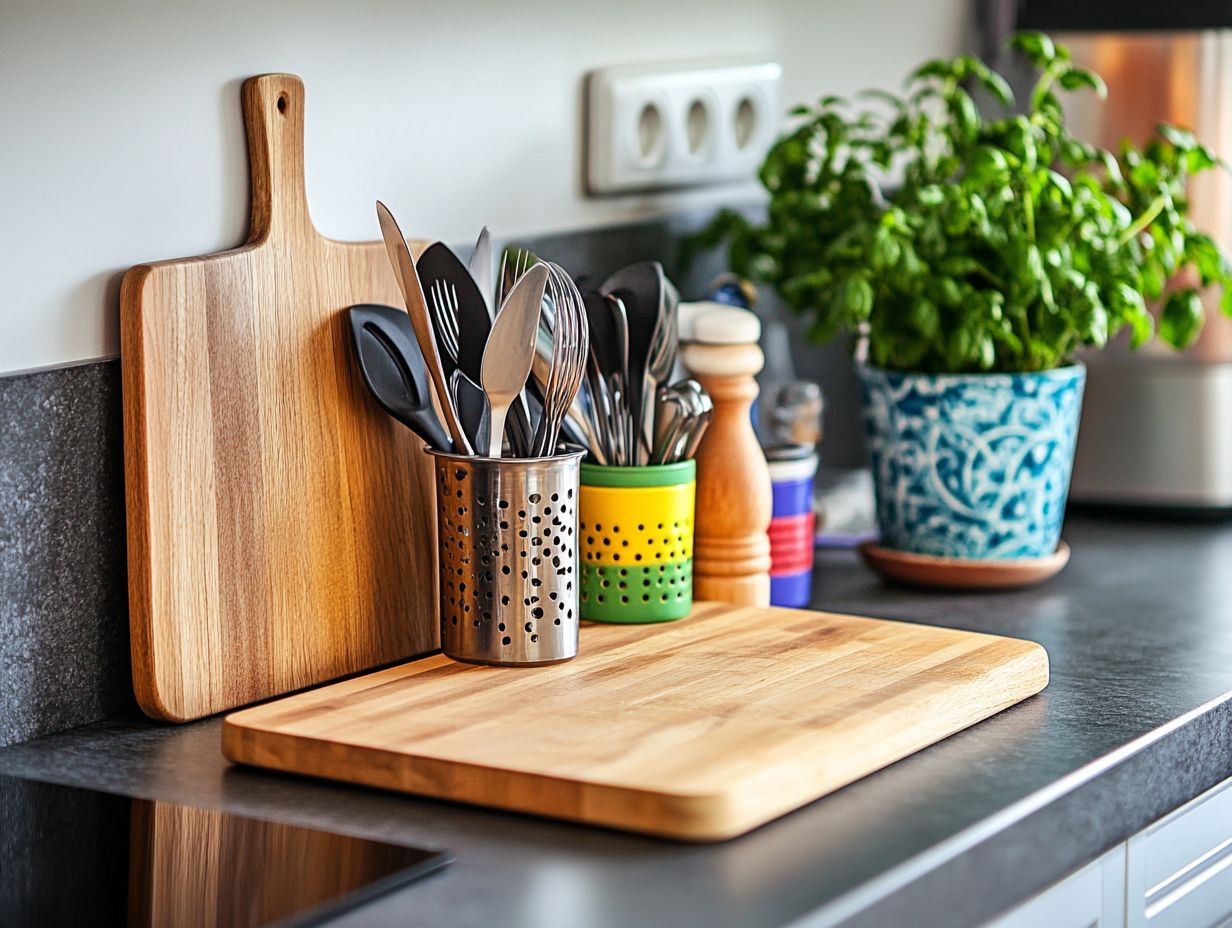
Effective storage and organization of your kitchen accessories can truly transform your cooking space, turning food preparation and cleanup into a seamless experience. By utilizing storage containers and a carefully curated set of kitchen tools, you can ensure easy access to frequently used items while keeping your countertops clear of clutter.
Implementing strategic organization tips allows you to maximize both space and functionality. This ensures that everything from reusable water bottles to wooden utensils is neatly stored and readily within reach.
To further enhance your kitchen efficiency, consider adding drawer dividers and tiered shelving. These practical solutions categorize your tools by type or usage frequency, enabling you to quickly grab what you need when cooking.
Magnetic strips for knives and wall-mounted racks for pots and pans are excellent choices to free up valuable counter space while keeping everything visible and accessible. This level of organization contributes to a tidier kitchen and enhances your cooking experience, allowing you to focus on creativity instead of sifting through cluttered drawers.
Choosing the Right Kitchen Accessories
Selecting the right kitchen accessories requires careful consideration of key factors such as quality, functionality, and maintenance needs.
High-quality kitchen accessories not only elevate your cooking experience but can also be customized. For tips on making them unique, check out how to personalize your kitchen accessories, which simplifies the cleaning and upkeep process.
When searching for wooden accessories or versatile kitchen tools, assess their durability and the level of care needed to maintain their performance and appearance over time.
Factors to Consider when Purchasing
When purchasing kitchen accessories, consider these important factors to make the best choice that prioritizes health. To help you choose wisely, refer to this guide on how to select kitchen accessories for your needs. Look for high-quality products with clear maintenance plans and regular cleaning routines. This approach promises long-term value and enhances functionality.
Understanding the significance of proper care for your kitchen equipment allows you to make informed selections. This helps you avoid products requiring excessive upkeep or those with a short lifespan.
Beyond quality and maintenance, consider the health implications of the materials used. Choosing non-toxic, food-safe materials is crucial to mitigate risks associated with chemical leaching into your food. Investigate the brand s reputation; it often reflects the longevity and safety of their products.
Investing time in reading reviews and seeking recommendations from trusted sources is highly encouraged. Making informed choices elevates your culinary experiences and significantly contributes to well-being in your kitchen environment. By prioritizing these factors, you can create a safe and functional kitchen that enhances both your cooking and health.
Replacing and Upgrading Your Accessories
Replacing and upgrading your kitchen accessories is essential for maintaining a safe and efficient cooking environment. To understand more about what to look for, check out key features of kitchen accessories. When items show signs of wear that could jeopardize food safety or performance, act quickly.
Recognizing when kitchen tools like worn-out cutting boards or frayed dish rags need replacement ensures a hygienic and functional kitchen. Regularly assessing your accessories allows you to upgrade to superior options that enhance your culinary experience and streamline your cooking process.
When to Replace and How to Upgrade

Knowing when to replace kitchen accessories and how to upgrade them is essential for maintaining hygiene and functionality in your kitchen. For instance, replace sponges regularly to prevent harmful bacteria from settling in. Upgrading from low-quality to high-quality kitchen equipment can boost your cooking efficiency and safety.
Recognizing the signs that it’s time to replace or upgrade whether it’s utensils or storage containers ensures a safe and efficient kitchen. Also, don t overlook items like cutting boards; they can harbor germs and should be replaced if excessively worn or cracked.
Investing in durable stainless-steel knives is another upgrade that enhances precision and safety, making meal prep quicker. Outdated non-stick pans? These pans are designed to prevent sticking, but they can become unsafe over time and should be swapped for safer alternatives.
Keep an eye on these must-have tools to boost your kitchen s efficiency! By opting for high-quality replacements, you can create a healthier kitchen.
Creative Uses for Kitchen Accessories
Exploring creative uses for kitchen accessories can elevate your food preparation experience. Everyday items can transform into versatile tools for innovative cooking methods or clever storage solutions.
By thinking outside the box, discover alternative applications for cutting boards, reusable water bottles, and dish rags to make your kitchen more functional and enjoyable, facilitating the creation of culinary delights.
Alternative Ways to Use Common Accessories
Many common kitchen accessories can be repurposed in creative ways, enhancing their functionality and efficiency. For instance, a wooden cutting board can transform into a serving platter.
Reusable water bottles? They keep you hydrated and can store your homemade dressings.
Consider a muffin tin: it s not just for baking; it s also an excellent organizer for small items, from crafting supplies to condiments. Utensil holders can become chic indoor planters for herbs, adding greenery to your kitchen.
Even old jars meant for preserving can stylishly store dry goods or pantry staples. Embrace versatility to optimize kitchen efficiency while discovering new ways to enhance your cooking adventures.
Frequently Asked Questions
How should I clean my kitchen accessories?

To keep your kitchen accessories clean, use warm soapy water and a soft cloth. For a more organized space, consider how to declutter your kitchen accessories and avoid harsh chemicals or abrasive scrubbers, as they can damage your accessories.
What is the best way to store my kitchen accessories?
The best way to store your kitchen accessories is in a designated cabinet or drawer. For tips on maximizing space, consider reading about how to organize your kitchen accessories efficiently. For delicate materials like glass or ceramic, use protective padding or dividers to prevent damage.
How often should I replace my kitchen accessories?
This depends on the type of accessory and frequency of use. Generally, replace cutting boards and dish towels every 1-2 years, while durable items like pots and pans can last several years with proper care.
Can I put my kitchen accessories in the dishwasher?
Check the label on your accessories for dishwasher safety. If unsure, hand wash to avoid damage.
How can I prevent rust on my metal kitchen accessories?
To prevent rust, dry your metal kitchen accessories thoroughly after washing.
A thin layer of vegetable oil on the surface creates a barrier against moisture.
What should I do if my wooden kitchen accessories show signs of wear?
If you see scratches or stains, gently sand them with fine-grit sandpaper.
Then, apply food-safe oil or wax to protect the surface.
For deeper scratches or serious damage, replacing the accessory might be necessary.


